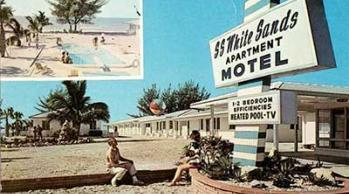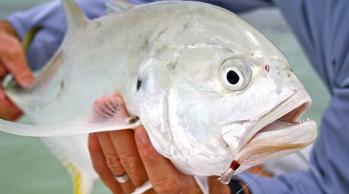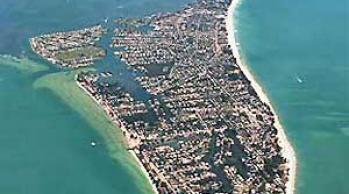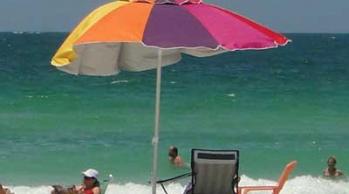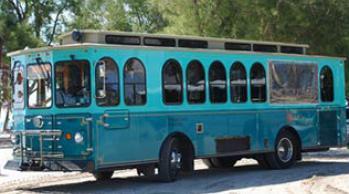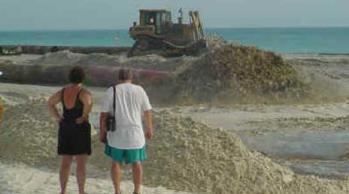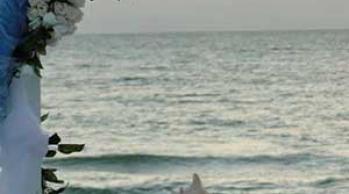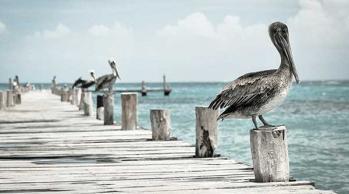Sea Turtles Need Your Help!
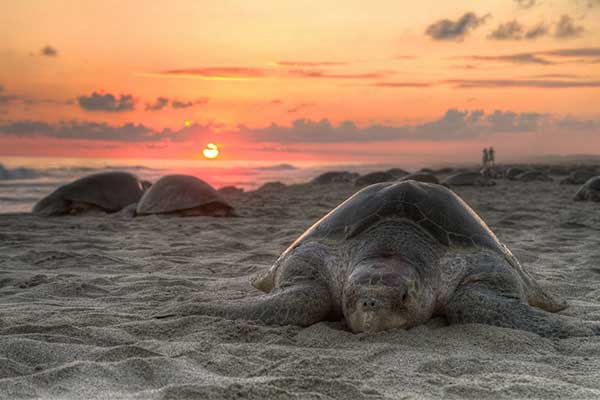
If you are visiting, or live near the beach, you can help by keeping outside lights off during turtle season from May through October.
Centuries ago, sea turtles roamed our oceans by the millions. In the last 100 years their numbers been greatly reduced. All seven species of sea turtles are in danger of extinction. Demand for sea turtle meat, eggs, and other by-products, as well as a loss of habitat, commercial fishing, and pollution have contributed to their decline.
The main danger for hatchlings is from artificial lighting. When the babies emerge, they instinctively move in the brightest direction. Normally, this would be the open night sky reflected by the ocean. On a developed beach, artificial lights attract the hatchlings, causing them to crawl in the wrong direction. Other dangers include obstructions on the beach, such as beach chairs, holes, or tire tracks, all of which can block their path to the sea.
If you are visiting, or live near the beach, you can help by keeping outside lights off during turtle season from May through October. Make sure to remove chairs, umbrellas and other gear from the beach each night. Level all sand castles and fill any holes dug during play. Please pick up all trash. Sea turtles mistakenly eat debris, especially plastic, which results in death. Never buy products made from sea turtles or any other endangered species
If you own , rent or use property near the Gulf, please pay special attention to this newsletter. It includes suggestions for low-cost ways to help the sea turtles, which are protected by the Endangered Species Act.
Thank you, Santa Rosa Island Authority
Information for this report was compiled from the Santa Rosa Island Authority and the Florida Department of Environmental Protection, "Understanding, Assessing, and Resolving Light-Pollution Problems on Sea Turtle Nesting Beaches."
These Steps Will Make Sea Turtles Safer
Residents can help make the area safer for sea turtles during their nesting and hatching season, which begins May 1 and concludes October 31. Less light means a better chance of survival for the sea turtles, which are protected by the Endangered Species Act.
Here's what you can do: For residential properties
- Remove unneeded fixtures or lights.
- Use low-pressure sodium vapor lights.
- Place outdoor lights on motion sensors so they don't burn needlessly.
- Attach shields to block beach side lights.
- Place security lights on motion sensors.
- Tint windows; close curtains after dark.
- Use directional fixtures which can be aimed down and away from the beach.
- Move fixtures to block them from beach view.
- Use yellow “bug” lights of 50 watts or less; they're less likely to attract sea turtles.
- Reduce height of fixtures.
- Place lights below dune line or shield with vegetation.
- Do not use spotlights on the beach.
How Beach Lighting Makes Sea Turtles Vulnerable
Lights, even from distant homes, can lead to the deaths of sea turtles and their hatchlings.

Light on the beach disorients the turtles and their hatchlings, luring them away from the water and leaving them vulnerable to other animals, exhaustion, passing automobiles and the morning sun.
Sea turtles nest in the dunes of Santa Rosa Island from May through August; the babies hatch from mid-July to the end of October.
At hatching time, up to 150 hatchlings burst from the nest and dash to the relative safety of the Gulf of Mexico. Moving quickly from the nest to the sea is vital to their survival.
But lights attract -- and endanger -- sea turtles. They are drawn away from the water by street lights, porch and deck lights, even lights visible through windows of buildings hundreds of feet away. This distraction can get them lost; a single light near a nesting beach can misdirect hundreds of turtles and lead to their death.
Lights and weather are major enemies of sea turtles. For example, 13 nests were found on Pensacola Beach last year. Twelve were loggerhead turtle nests and one was a nest for green turtles.
Four nests were lost to Hurricane Earl, which rumbled erratically through the Gulf of Mexico in early July before coming ashore near Panama City.
Hatchlings at all of the remaining nests were disoriented and began crawling toward lights in the area. National Park Service staffers were present to reorient most of the hatchlings, but two of the nests hatched when Park Service personnel were not present. Some of these hatchlings were rescued but most died.
Beach Park Lights Repositioned to Minimize Distraction
Gulf Power crews have redirect the lights at the recreation park at the gate to Fort Pickens to help encourage survival of sea turtles, which are protected by the Endangered Species Act.

Three tall light poles and their lamps have been redirected so they shine toward the north, away from the Gulf of Mexico. This should reduce distractions for sea turtles nesting nearby and encourage the hatchlings to travel directly to the gulf.
This was just one of several trouble spots found during a recent survey of Pensacola Beach's gulf front to determine areas of excessive lighting that can hurt sea turtles. The survey was conducted by a team of representatives from the Santa Rosa Island Authority, Gulf Power, the National Park Service, the Pensacola Beach Residents & Leaseholders Association, and the Pensacola Beach Chamber of Commerce.
The survey showed the extensive impact of lights, with many seen from the beach even though they were in homes not directly on the gulf. Beach areas were illuminated by lights from as far away as the north side of Fort Pickens Road and Ariola Drive.
Island Authority staffers havel contacted leaseholders who had the highest concentration of lights and discuss ways to reduce light shining on the beach.
The Island Authority encourages citizen cooperation. If you see sea turtles on the beach, please call the National Park Service, 850-916-3010.
If you have questions about your lights and their possible impact on sea turtles, please call Island Authority, 850-932-2257. They will be glad to work with you.
Choose Lights That Won't Hurt Sea Turtles, Hatchlings

Low-pressure sodium-vapor (LPS) lighting emits a pure-yellow light that seems to affect nesting turtles less than light from other sources, at least for loggerheads and green turtles, the most common turtles on Santa Rosa Island. LPS lighting has both advantages and disadvantages:
Expense : LPS initially costs substantially more than incandescent or fluorescent lights because it uses more expensive bulbs and ballasts . But operating costs are generally much lower for LPS than for any other commercial source.
Color -- LPS sources are monochromatic and therefore give poor color rendition. But full-spectrum color is seldom needed for safety and security. For example, U.S. Air Force bases near nesting beaches in Florida use LPS lights for most outside security areas.
Disposal -- The lamps within LPS luminaries contain elemental sodium, which can cause fires if disposed of carelessly. However, unlike some other lamps, the contents of LPS lamps are not toxic.
Availability -- LPS luminaries are not as readily available in retail stores as other light sources, but manufacturers offer a wide selection.
When using other conventional lighting systems, adjust the fixtures to keep the light from being visible from the nesting beach. Completely shielding fixtures with a sheet of metal flashing can reduce stray light reaching the beach. Louvered step lighting is one of the best ways to light balconies that are visible from nesting beaches. For parking areas near nesting beaches, low-mounted, louvered bollard fixtures are preferred, but fully hooded floodlights also can direct light accurately and reduce stray light.
Q&A: Answers to Frequent Questions About Sea Turtles
When do hatchling sea turtles emerge from their nests?
In the Southeast, hatchlings emerge in June, July, August, September and October. It is a myth that hatchlings emerge only around the time of a full moon. Hatchlings ready to emerge wait just beneath the sand surface until conditions become cool. This temperature cue prompts them to emerge primarily at night, although some have emerged in late afternoon or early morning.
When they emerge from their nests, how do hatchling sea turtles know where the Gulf is?
They have an inborn tendency to move in the brightest direction. On a beach, the brightest direction is most often the open view of the night sky over, and reflected by, the gulf. Hatchlings also tend to move away from darkly silhouetted objects such as dunes and vegetation.
My neighbors' lights are visible from the beach. Why should I modify the lights on my beachfront property?
Sea turtles benefit from any reduction of artificial lighting on the nesting beach. As lighting is reduced, hatchlings will have a better chance of reaching the sea.
How bright can a light be without affecting sea turtles?
Unfortunately, no simple measure of light intensity can reveal whether a light source is a problem. . . Any light that is visible from the beach is likely to cause problems. Will placing bright lights on platforms offshore guide hatchlings into the water off lighted beaches? Apart from being overly expensive and complicated, lighting the gulf to draw hatchlings offshore probably would create more problems, such as interfering with hatchling dispersal and making the babies more vulnerable to predatory fish. How expensive is a beach-darkening program? The simplest solution -- turning off lights visible from the beach during the nesting season -- costs little or nothing and may actually save electricity costs.
Most of the essential lighting that remains can be easily shielded so that the light performs its intended function without reaching the beach. Proper shields can be made from inexpensive metal flashing and fastened with screws.
Replacing fixtures is more expensive but is necessary only when an owner is concerned about lighting efficiency or aesthetics. Choosing well-designed fixtures and incorporating light-management techniques into the plans for coastal development are the most effective ways to fulfill lighting needs while protecting sea turtles.
Sea Turtle Trivia
- Florida beaches are home to 80% of Loggerhead turtles in the U.S.
- Turtles can migrate thousands of miles, but usually return to lay their eggs on the same beach where they hatched
- Sea turtles have existed for over one hundred million years
- It can take 15 - 50 years before a sea turtle is capable of reproducing
- Scientists estimate that only 1 in 1000 to 10,000 babies will survive to adulthood
- Sea turtles live their entire life in the ocean. The only time they comes ashore is when the female lays her eggs.
- Sea turtles are reptiles. They breathe air, and can hold their breath for long periods of time.
- When its time to sleep, a loggerhead will wedge under a rock close to the shore, or take a snooze while floating on the surface of deep water
- Hatchlings weigh less than one ounce and are only two inches long. Adults can grow over 3 feet long and weigh 200 to 300 pounds!
- The nest temperature during incubation determines a sea turtle's sex. Boys like it cool - Girls like it hot.
- Sea turtles have great underwater vision, but are nearsighted out of the water.
- Although sea turtles do not have external ears, they are capable of hearing low frequency sounds and vibrations
- Sea turtles use their strong jaws to crush a diet of crabs, shrimp, mussels, and jelly fish
LEARN ABOUT THE DIFFERENT TYPES OF SEA TURTLES....
| LOGGERHEAD | HAWKSBILL | GREEN | LEATHERBACK | OLIVE RIDLEY |
|---|---|---|---|---|
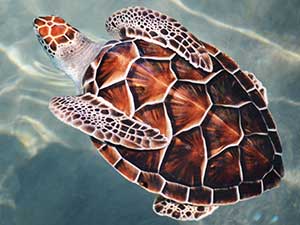 |
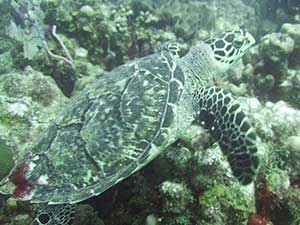 |
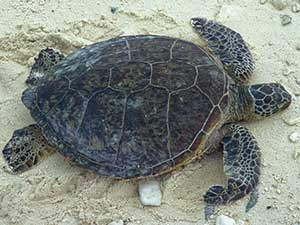 |
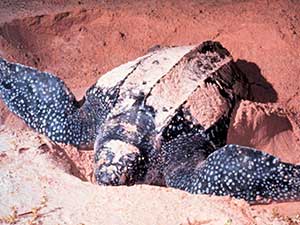 |
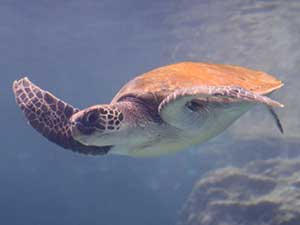 |

